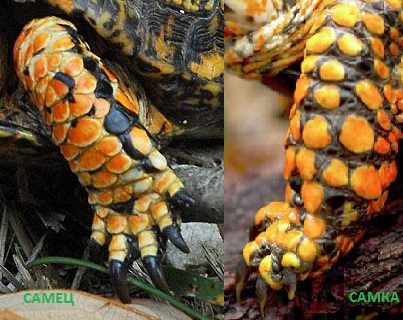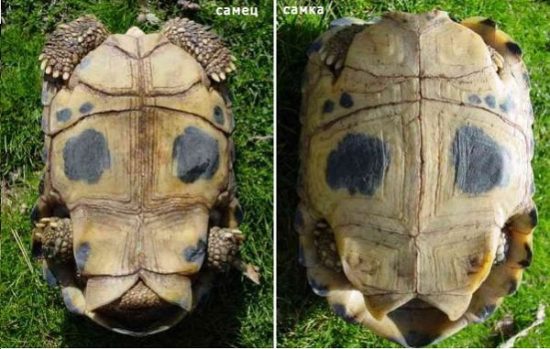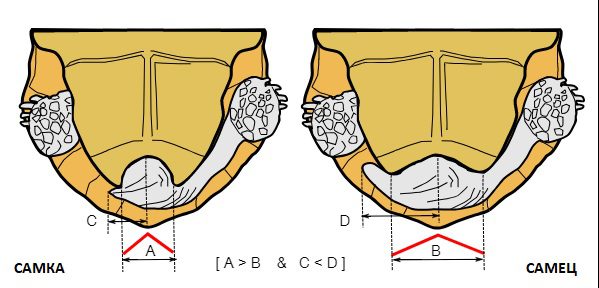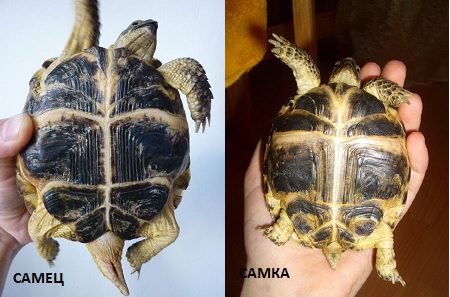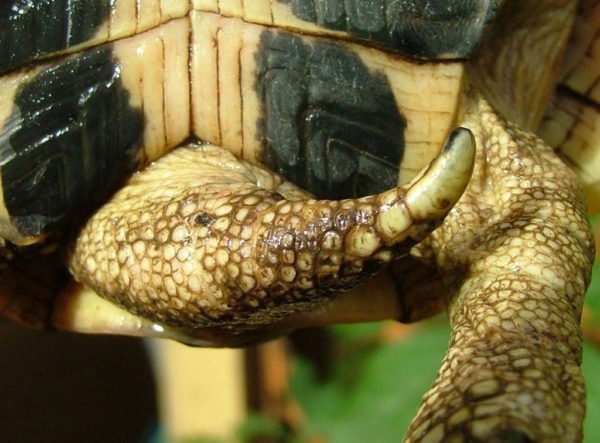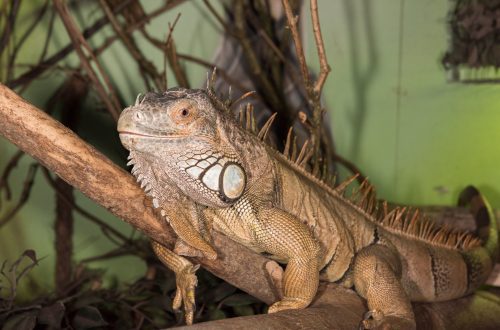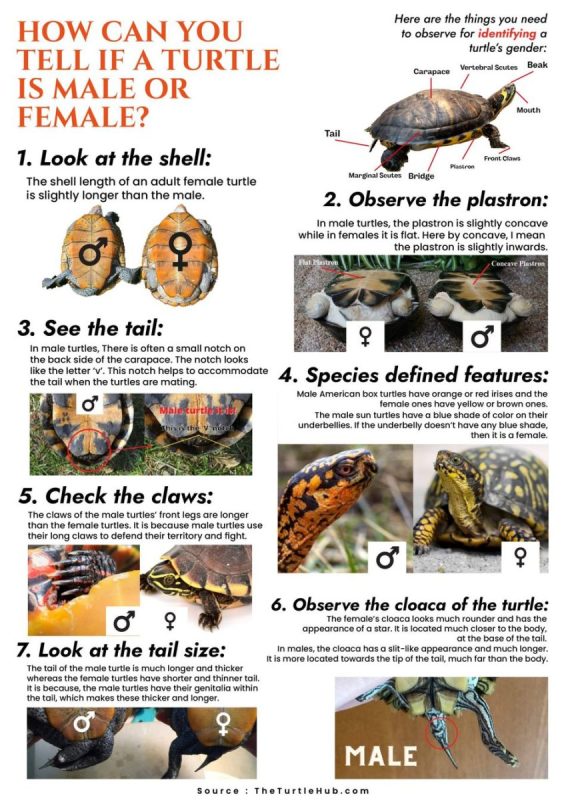
How to determine the sex of a land turtle (Central Asian): learning to distinguish between males and females
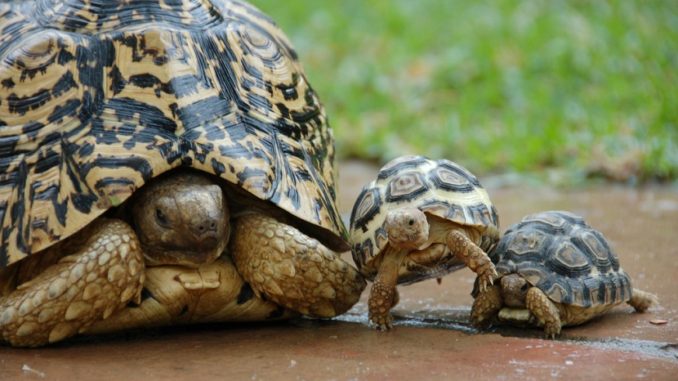
When getting a new pet, the owners, of course, want to know which land tortoise – male or female, will settle in their house. This information is needed to give a nickname to a new family member, but is even more significant when choosing a couple or moving a newcomer to old tenants. But it is very difficult to determine the sex of a land turtle, especially in babies, so mistakes are often made.
Contents
At what age can you find out the sex of a turtle
You can determine the sex and age of a land tortoise through its visual inspection. Particular difficulties arise in order to determine the sex and age of the Central Asian tortoise. When buying a small Central Asian tortoise, it is almost impossible to distinguish a female from a male. Babies under 2,5 years old do not yet show external signs of sex, visually they look exactly the same. But even sexually mature individuals are difficult to distinguish. Veterinarians believe that it is possible to determine the sex of a Central Asian land tortoise only at the age of 6-8 years, and it will be possible to recognize the genus of a pet even more accurately after 10 years.
Finding out how old a Central Asian tortoise is easier, you can do this by looking at the shell. To do this, you need to count the veins on the shields. In babies under the age of two years, the groove appears about once every three months. During this time, the turtle can form 8-12 rings. In an adult, one ring is formed in 12 months. It should be noted that in turtles that do not hibernate, the rings have blurry and fuzzy boundaries.
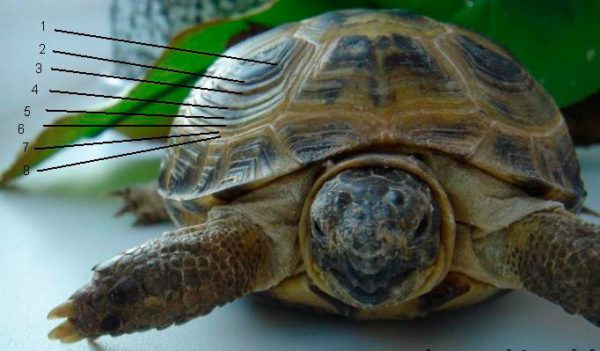
Age is also indicated by the size of the animal – in the first three years of life, the turtle grows up to 10 cm, and by the age of 10 it reaches a length of 18-20 cm. These data may be inaccurate – if the animal was kept in poor conditions, its size will be smaller than normal. 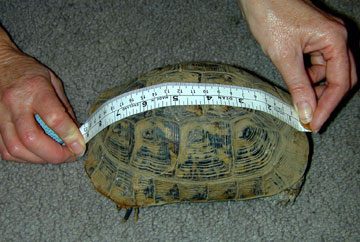
Visual difference
It is easiest to distinguish a male from a female at home by a number of external signs. Girls in turtles are often larger than boys – this is due to the need to produce offspring. But the difference between a male and a female in size can be seen only if the terrarium contains several individuals of different sexes, and with negative factors (lack of food, illness), the female can grow smaller than the male. In some species, differences in the shell are pronounced – in the males of the Indian tortoise, the tubercles on the shell are pronounced, while in the females they are smoothed out.
A more reliable way to tell the sex of a tortoise is by looking at the tail and underside of the shell. After the first years of life, these parts of the reptile’s body change significantly, taking on a slightly different shape in males and females. The easiest way to see the difference is if the pet is not kept alone and it is possible to compare the external signs of several individuals. To properly inspect, you need to take the turtle in your hands, then step by step follow these steps:
- Gently turn the pet over so that the lower surface of the shell and tail become visible (it is better not to turn the turtle over completely, this is a very uncomfortable position for it).
- Look at the paws of a reptile – in girls, the claws are thinner and shorter, in boys they will be noticeably larger and longer, this is due to the need to take a stable position during mating (but if the pet is kept on a hard bedding, its claws will grind down a lot).

- Examine the shields of the bottom of the shell – in females they are flat and even, in males they are slightly concave, also to facilitate mating.

- Pay attention to the hole for the tail – in boys, the plastron shields will be pronounced bent towards the ground, in girls they will be even.

- Inspect the reptile’s tail – you can identify the female by a shorter, neat, triangular tail. The male is distinguished by an elongated, thick tail at the base, which he tucks to one side.
- Look at the opening of the cloaca – in the female it is located closer to the edge of the shell and has a round shape, in the male, the distance from the edge of the shell is greater and the hole has an elongated shape, similar to a longitudinal strip.

- It is important to pay attention to the tip of the tail – it has a small horn tip, very pronounced in males and almost imperceptible in females. Boys also have horny growths on the inside of their hind legs – spurs – which help them to stay on the female’s shell during mating.

- In some species of tortoises, such as box turtles, eye color is sexually dimorphic: females have yellowish, brown or light red, while males have a rich red color.

Differences in behavior
In addition to visual signs, it is also possible to distinguish a land tortoise of a boy from a girl by carefully observing the behavior of animals. The female is usually calm and unhurried, when examining the surroundings, she smoothly stretches her neck and slowly turns her head. Males are more aggressive and often try to escape from the terrarium, they can hiss at the owners and even try to bite the fingers. Sometimes you can see how the boy shakes his head up and down or turns his tail from side to side – this behavior during the mating season helps to attract the attention of the female.
IMPORTANT: The behavior of pets that are kept alone will be calmer. Even males show almost no aggression if there are no rivals nearby and there is no need to fight for territory or win the attention of a female. Therefore, it is usually impossible to understand by the behavior of which sex a turtle that lives alone.
Scientific method
It is impossible to truly accurately determine the sex of a land tortoise at home. Therefore, when deciding to start breeding reptiles, it is recommended to contact the clinic, where they will conduct a thorough visual examination of the animal in accordance with its species, and make additional tests. A specialist doctor will study the composition of the blood, the hormonal background, and make an ultrasound to examine the internal parts of the genital organs (testes and ovaries). Such an examination will help to find out the sex of the animal and check if the pet has any diseases and contraindications for reproduction.
Video: how to distinguish sex in Central Asian turtles
How to distinguish a land turtle boy from a girl: ways to determine sex
4.7 (93.33%) 15 votes



